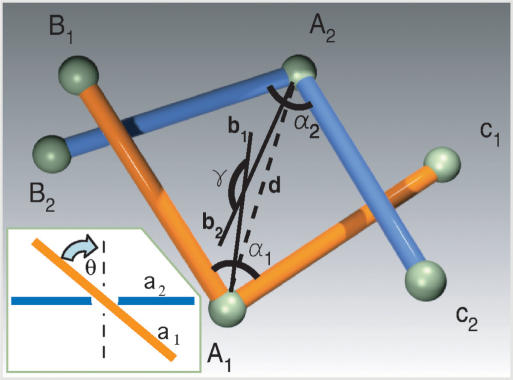Figure 1.
Geometry of juxtapositons. Juxtaposition of two two-segment-long subchains with central vertices A1 and A2. To describe the geometry of the juxtapositions we use the distance d, the opening angles α1 and α, the facing angle γ (between the bisectrices b1 and b2) and the geometrical chirality angle θ between unoriented tangential lines passing through the vertices A1 and A2 (see the Inset). To consider juxtapositions as inter-hooked the following three conditions have to be fulfiled: (i) each subchain intersects with a sector of the plane extending from angle a defined by the other subchain. (ii) The angle γ > 105°. (iii) the mean opening angle (α1 + α2)/2 < 22.5°. Inset: Geometric chirality between two unoriented lines in space. The two lines are projected on the plane that is parallel to both the lines while the projection conserves the information which of the lines was closer and which was further from the observer. Perpendicular lines are considered as achiral while the geometric chirality angle is the smallest angle of rotation applied to the overlying line in order to make it perpendicular to the underlying line. In the case of positive (right-handed) chirality, a clockwise rotation of the overlying line is required to make it perpendicular to the underlying line (shown), while a counterclockwise rotation would be required for lines with negative (left-handed) geometric chirality. The bigger the angle of the rotation, the higher the absolute value of the geometric chirality.

